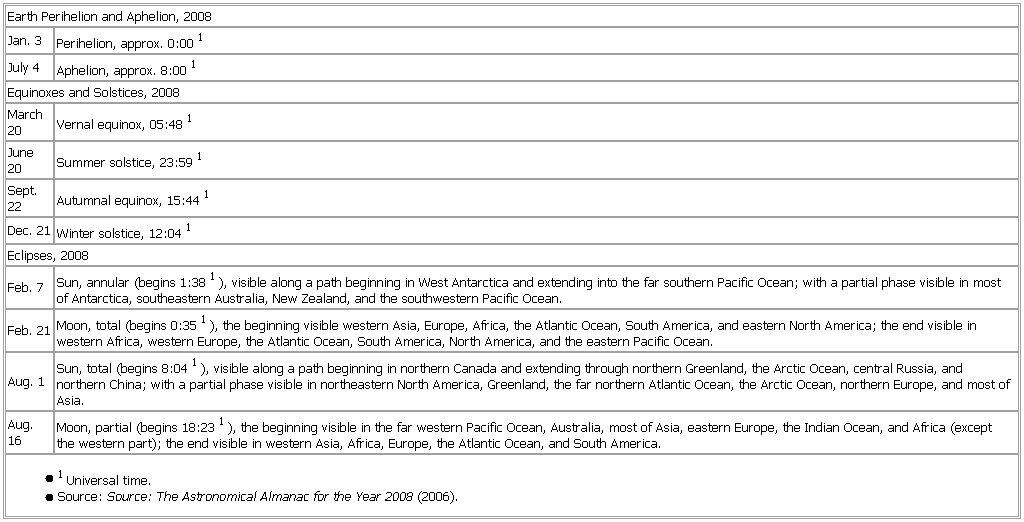Earth Perihelion and Aphelion, 2008
- Earth Perihelion and Aphelion, 2008
-
Earth Perihelion and Aphelion, 2008
Jan. 3 Perihelion, approx. 0:001
July 4 Aphelion, approx. 8:001
Equinoxes and Solstices, 2008
March 20 Vernal equinox, 05:481
June 20 Summer solstice, 23:591
Sept. 22 Autumnal equinox, 15:441
Dec. 21 Winter solstice, 12:041
Eclipses, 2008
Feb. 7 Sun, annular (begins 1:381), visible along a path beginning in West Antarctica and extending into the far southern Pacific Ocean; with a partial phase visible in most of Antarctica, southeastern Australia, New Zealand, and the southwestern Pacific Ocean.
Feb.
21 Moon,
total (
begins 0:351),
the beginning visible western Asia,
Europe,
Africa,
the Atlantic Ocean,
South America,
and eastern North America;
the end visible in western Africa,
western Europe,
the Atlantic Ocean,
South America,
North America,
and the eastern Pacific Ocean.
Aug.
1 Sun,
total (
begins 8:041),
visible along a path beginning in northern Canada and extending through northern Greenland,
the Arctic Ocean,
central Russia,
and northern China;
with a partial phase visible in northeastern North America,
Greenland,
the far northern Atlantic Ocean,
the Arctic Ocean,
northern Europe,
and most of Asia.
Aug.
16 Moon,
partial (
begins 18:231),
the beginning visible in the far western Pacific Ocean,
Australia,
most of Asia,
eastern Europe,
the Indian Ocean,
and Africa (
except the western part);
the end visible in western Asia,
Africa,
Europe,
the Atlantic Ocean,
and South America.
● 1Universal time.
● Source: Source: The Astronomical Almanac for the Year 2008 (
2006).
See as table:
* * *
Universalium.
2010.
Look at other dictionaries:
Earth — This article is about the planet. For other uses, see Earth (disambiguation). Earth … Wikipedia
Earth's orbit — In astronomy, The Earth s Orbit involves the Earth orbiting the Sun at an average distance of about 150 million kilometers every 365.2564 mean solar days (1 sidereal year). From Earth, this gives an apparent movement of the Sun with respect to… … Wikipedia
Physical Sciences — ▪ 2009 Introduction Scientists discovered a new family of superconducting materials and obtained unique images of individual hydrogen atoms and of a multiple exoplanet system. Europe completed the Large Hadron Collider, and China and India took… … Universalium
Near-Earth object — Asteroid 4179 Toutatis is a potentially hazardous object that has passed within 2.3 lunar distances … Wikipedia
Near-Earth asteroid — Near Earth asteroids (NEAs) are asteroids whose orbits are close to Earth s orbit. All near Earth asteroids spend part of their orbits between 0.983 and 1.3 astronomical units away from the Sun. Some near Earth asteroids orbits intersect Earth s… … Wikipedia
C/2008 T2 (Cardinal) — Discovery Discovered by: Rob D. Cardinal[1] Discovery date: October 1, 2008[1] Orbital characteristics A … Wikipedia
Apsis — For the architectural term, see Apse. Aphelion and Perihelion redirect here. For Edenbridge s Album, see Aphelion (album). Apogee and Perigee redirect here. For the literary journal, see Perigee: Publication for the Arts. For other uses, see… … Wikipedia
Sun — This article is about the star. For other uses, see Sun (disambiguation). The Sun … Wikipedia
Solstice — For other uses, see Solstice (disambiguation). UTC date and time of solstices and equinoxes[1] year Equinox Mar Solstice June Equinox Sept Solstice Dec day time day time day time day time 2004 20 … Wikipedia
Jupiter — This article is about the planet. For other uses, see Jupiter (disambiguation). Jupiter … Wikipedia

